Creating Sustainable Garden Designs: A How-To Guide for Professionals
- JD Landscaping
- Jun 20, 2024
- 2 min read
Updated: Jun 23, 2024
In today's world, where environmental concerns are at the forefront of our minds, creating sustainable garden designs has become a top priority for professionals in the landscaping and gardening industry. Sustainable gardens are not only visually appealing but also play a crucial role in contributing to a healthier ecosystem. If you are a professional looking to enhance your knowledge and skills in sustainable gardening practices, this how-to guide is just for you!
1. Understanding the Principles of Sustainable Garden Design
Sustainable garden design is centered around the idea of creating landscapes that are environmentally friendly, resource-efficient, and resilient. To achieve this, professionals should focus on the following key principles:
Water Conservation : Implementing water-efficient irrigation systems, rainwater harvesting techniques, and selecting drought-resistant plants to reduce water usage.
Native Plants : Incorporating native plants in garden designs not only promotes biodiversity but also requires less maintenance and water, contributing to overall sustainability.
Composting : Utilizing composting methods to recycle organic waste into nutrient-rich soil, reducing the reliance on chemical fertilizers.
Wildlife Habitat : Creating spaces within gardens that attract beneficial insects, birds, and other wildlife to support the local ecosystem.
2. Designing a Sustainable Garden: Step-by-Step Process
Before starting any garden design project, conduct a thorough assessment of the site. Consider factors such as sunlight exposure, soil quality, water availability, and existing flora and fauna.
Develop a detailed plan that incorporates the principles of sustainable gardening. Opt for designs that promote biodiversity, maximize water retention, and minimize maintenance requirements.
Choose native or adaptive plants that are well-suited to the local climate and soil conditions. Diversity in plant selection is key to creating a resilient and vibrant garden ecosystem.
Implement water-efficient irrigation systems, such as drip irrigation or rain gardens, to minimize water waste and promote healthy plant growth.
Focus on improving soil health through the use of compost, mulch, and organic fertilizers. Healthy soil is the foundation for a thriving garden ecosystem.
Regularly monitor the garden for pest infestations, diseases, and other issues. Practice sustainable maintenance techniques, such as hand weeding and natural pest control methods.
3. Incorporating Sustainable Garden Designs in Urban Landscapes
Sustainable garden designs are not limited to residential settings; they can also be implemented in urban landscapes to create green spaces that benefit both the environment and the community. Professionals working in urban areas can take the following steps to promote sustainability:
Green Roofs : Designing green roofs on buildings can help reduce urban heat island effects, improve air quality, and provide habitats for pollinators.
Vertical Gardens : Utilizing vertical gardening techniques on walls and fences can maximize green space in urban environments and improve aesthetics.
Community Gardens : Establishing community gardens in urban areas can foster a sense of community, promote healthy eating habits, and educate the public on sustainable gardening practices.

Conclusion
As professionals in the landscaping and gardening industry, adopting sustainable garden designs is not only a responsible choice but also a rewarding one. By following the principles of sustainability, incorporating native plants, and implementing water-wise techniques, you can create beautiful and eco-friendly garden spaces that benefit the environment and enhance the well-being of communities. Let's work together to cultivate a greener and more sustainable future through our garden designs! jdlandscapingny.com






Comments